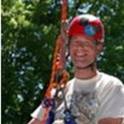Friction is important in tree care operations; climbers encounter friction when ascending into, working in, and descending out of a tree. Twelve commonly used climbing ropes were tested on cambium saver rings made of three different materials to determine rope on ring static and kinetic friction coefficients. All ropes were tested before any field use. In addition, two ropes were tested after they had been used in the field for 2 years and were evaluated to determine the effect of rope wear on friction. Friction coefficients varied among ropes and ring materials, and surface roughness of ring material was the best predictor of friction coefficient. Used ropes exhibited higher friction coefficients than new ropes and, in most cases, superseded the influence of surface roughness of cambium saver rings. Simple physical models were developed to illustrate how friction coefficients can affect different aspects of tree climbing. There are important implications of these results for further studies on rope friction as it relates to reducing climber fatigue.
- climbing,
- friction coefficient,
- rope friction
Available at: http://works.bepress.com/brian_kane/16/
